MSW Management in Universities: Sharing Best Practices
Abstract
:1. Introduction
2. Materials and Methods
- one uphill campus located in the town of Trento (about 117,000 inhabitants) with six departments,
- one downtown campus also located in Trento, with three departments, one faculty, and one research center),
- one campus in the town of Rovereto (about 39,000 inhabitants), including one department and one research center.
- analysis of current waste collection methods, including product analysis,
- cost analysis,
- assessment questionnaire by students,
- project of improvement interventions.
- analyze the strategy of MSW management in each case study, pointing out the aspect most relevant (positively and negatively) in term of sustainable management,
- propose improvements for each case study,
- discuss comparatively what emerged from the case studies.
3. Results and Discussion
- In some cases, the external areas have been accessed by unauthorized users that deliver their RMSW to avoid paying the waste management tariff,
- Sometimes the external containers are left open by the cleaning staff and this allowed the utility company to empty the containers and invoice the entire volume of the containers as RMSW volume,
- Generic waste bins are still present in many corridors and rooms, and this might induce the users to get rid of their waste without correct separation,
- Low SC performance still occurs in university buildings, and this might be related to the fact that about 11% of the students come from municipalities where the waste fractions are collected differently [28].
- removing generic waste bins from the university buildings,
- setting up periodical communication campaigns to clearly inform the users (both students and employees) on how to correctly separate the waste fractions,
- developing a standard procedure for the correct management of waste containers in the external areas to avoid the emptying of partially filled containers by the utility company,
- implementing a surveillance strategy to monitor the external areas and avoid unauthorized users to enter.
- it includes short instructions about the separate waste collection (what kind of waste should be put in baskets, etc.),
- it has two most prevalent types of waste: plastic and paper,
- waste is collected by the organization “Ecotechnology”, which also provides educational courses for students,
- an insufficient volume of waste bins throughout the university buildings was found,
- an absence of organic and glass collection bins emerged.
- unsuitable basket’s condition,
- undifferentiated baskets,
- absence of separate waste collection,
- lack of baskets in some campus areas.
- There are no separate waste collection baskets at dormitories and other buildings,
- University and organizations do not provide accurate data about overall waste collection, especially about the separate waste collection,
- In some campus territories, there is a lack of undifferentiated baskets causing problems with overall waste collections.
- Three waste management systems discussed above, have several drawbacks that should be taken into account. UniTrento demonstrated the most efficient waste management system whereas UrFU showed the initial stage of the SC implementation. The summarized data and advisable improvements in the waste management system at universities are provided in Table 3.
4. Conclusions
Author Contributions
Funding
Acknowledgments
Conflicts of Interest
References
- Zulkifli, A.A.; Yusoff, M.Z.M.; Manaf, L.A.; Zakaria, M.R.; Roslan, A.M.; Ariffin, H.; Shirai, Y.; Hassan, M.A. Assessment of municipal solid waste generation in Universiti Putra Malaysia and its potential for green energy production. Sustainability 2019, 11, 3909. [Google Scholar] [CrossRef] [Green Version]
- Ramamoorthy, R.; Poyyamoli, G.; Kumar, S. Assessment of solid waste generation and management in selected school campuses in Puducherry region, India. Environ. Eng. Manag. J. 2019, 18, 499–512. [Google Scholar]
- Jayaprakash, J.; Jagadeesan, H. Sustainable Waste Management in Higher Education Institutions—A Case Study in AC Tech. In Green Engineering for Campus Sustainability; Anna University: Chennai, India, 2019; pp. 163–172. [Google Scholar]
- Rodzi, R.M.; Nopiah, Z.M.; Basri, N.E.A. Analysis of solid waste generation and composition in Malaysia TVET campus. Int. J. Integr. Eng. 2019, 11, 158–170. [Google Scholar]
- Yusoff, S. Toward integrated and sustainable waste management system in University of Malaya: UM zero waste campaign. E3S Web Conf. 2018, 48, 04007. [Google Scholar] [CrossRef]
- Rada, E.C.; Bresciani, C.; Girelli, E.; Ragazzi, M.; Schiavon, M.; Torretta, V. Analysis and measures to improve waste management in schools. Sustainability 2016, 8, 840. [Google Scholar] [CrossRef] [Green Version]
- Adeniran, A.E.; Nubi, A.T.; Adelopo, A.O. Solid waste generation and characterization in the University of Lagos for a sustainable waste management. Waste Manag. 2017, 67, 3–10. [Google Scholar] [CrossRef] [PubMed]
- Tiew, K.G.; Kruppa, S.; Basri, N.E.A.; Basri, H. Municipal solid waste composition study at Universiti Kebangsaan Malaysia campus. Aust. J. Basic Appl. Sci. 2010, 4, 6380–6389. [Google Scholar]
- Liao, C.; Li, H. Environmental education, knowledge, and high school students’ intention toward separation of solid waste on campus. Int. J. Environ. Res. Pub. Health 2019, 16, 1659. [Google Scholar] [CrossRef] [PubMed] [Green Version]
- De Feo, G.; Ferrara, C.; Iannone, V.; Parente, P. Improving the efficacy of municipal solid waste collection with a communicative approach based on easily understandable indicators. Sci. Tot. Environ. 2019, 651, 2380–2390. [Google Scholar] [CrossRef] [PubMed]
- Grodzińska-Jurczak, M. The relation between education, knowledge and action for better waste management in Poland. Waste Manag. Res. 2003, 21, 2–18. [Google Scholar] [CrossRef] [PubMed]
- Rada, E.C.; Cioca, L.I. Optimizing the Methodology of Characterization of Municipal Solid Waste in EU under a Circular Economy Perspective. Energy Procedia 2017, 119, 72–85. [Google Scholar] [CrossRef]
- Sustainable Development Goals. Available online: https://sustainabledevelopment.un.org/?menu=1300 (accessed on 14 May 2020).
- Perotto, E.; Prandstraller, A. Sustainable waste management at Universities. In Proceedings of the 17th International Waste Management and Landfill Symposium, Forte Village, Cagliari, Italy, 30 September–4 October 2019. [Google Scholar]
- RUS®. Available online: https://sites.google.com/unive.it/rus/home (accessed on 1 April 2020).
- Malinauskaite, J.; Jouhara, H.; Czajczyńska, D.; Stancev, P.; Katsou, E.; Rostkowski, P.; Thorne, R.J.; Colon, J.; Ponsa, S.; Al-Mansour, F.; et al. Municipal solid waste management and waste-to-energy in the context of a circular economy and energy recycling in Europe. Energy 2017, 141, 2013–2044. [Google Scholar] [CrossRef]
- Plastinina, I.; Teslyuk, I.; Dukmasova, N.; Pikalova, E. Implementation of circular economy principles in regional solid municipal waste management: The case of Sverdlovskaya Oblast (Russian Federation). Resources 2019, 2, 90. [Google Scholar] [CrossRef] [Green Version]
- Rumyantseva, A.; Berezyuk, M.; Savchenko, N.; Rumyantseva, E. Modern Technologies of Processing Municipal Solid Waste: Investing in the Future. IOP Conference Series: Earth and Environmental Science; IOP Publishing: Bristol, UK, 2012; Volume 72, p. 012015. [Google Scholar]
- Fomin, E.P.; Alekseev, A.A.; Fomina, N.E.; Dorozhkin, V.E. The scenario approach to the development of regional waste management systems (Implementation experience in the regions of Russia). Int. J. Environ. Sci. Educ. 2016, 11, 7551–7562. [Google Scholar]
- Rapporto Rifiuti Urbani (Urban Waste Report)—Edizione 2019. Available online: http://www.isprambiente.gov.it/files2019/pubblicazioni/rapporti/Rapporto%20Rifiuti%20Urbani_Dati%20di%20Sintesi_n%20314_2019_DEF.pdf (accessed on 1 April 2020).
- Rada, E.C.; Zatelli, C.; Mattolin, P. Municipal solid waste selective collection and tourism. WIT Trans. Ecol. Environ. 2014, 180, 187–197. [Google Scholar]
- Ragazzi, M.; Fedrizzi, S.; Rada, E.C.; Ionescu, G.; Ciudin, R.; Cioca, L.I. Experiencing Urban Mining in an Italian Municipality towards a Circular Economy vision. Energy Procedia 2017, 119, 192–200. [Google Scholar] [CrossRef]
- Schiavon, M.; Ragazzi, M.; Coller, G.; Ferronato, N.; Torretta, V.; Rada, E.C. A methodology to support decisions towards economic and environmental sustainability in public contexts: Application to hand-drying options. WIT Trans. Ecol. Environ. 2019, 222, 59–71. [Google Scholar]
- Rada, E.C.; Zatelli, C.; Cioca, L.I.; Torretta, V. Selective collection quality index for municipal solid waste management. Sustainability 2018, 10, 257. [Google Scholar] [CrossRef] [Green Version]
- Di Di Foggia, G.; Beccarello, M. The impact of a gain-sharing cost-reflective tariff on waste management cost under incentive regulation: The Italian case. J. Environ. Manag. 2020, 265, 110526. [Google Scholar] [CrossRef] [PubMed]
- Ferronato, N.; Dalla Valle, L.; Torretta, V. Valutazione della gestione dei rifiuti urbani in un campus universitario italiano: Verso una migliore raccolta differenziata (Assessment of municipal waste management on an Italian university campus: To a better selective collection). Ingegneria Dell’ambiente 2018, 5, 333–346. [Google Scholar]
- Association of Green Universities in Russian Federation. Available online: http://xn--b1afaaheyr0d3de.xn--p1ai/ (accessed on 1 April 2020).
- Ragazzi, M.; Rada, E.C.; Abbà, A.; Schiavon, M. Parameters analysis for a sustainable management of solid waste in university buildings. In MATEC Web of Conferences, Proceedings of the 2019 8th International Conference on Transportation and Traffic Engineering (ICTTE 2019), Auckland, New Zealand, 19–21 December 2019; EDP Sciences: Les Ulis, France, 2020; Volume 305, p. 00054. [Google Scholar]
- ANPA. Analisi Merceologica dei Rifiuti Urbani; Technical Report RTI CTN_RIF 1/2000; Agenzia Nazionale per la Protezione dell’Ambiente: Rome, Italy, 2000. [Google Scholar]
- Official Website of UrFU Student Organization. Available online: https://posurfu.ru/ (accessed on 14 May 2020).
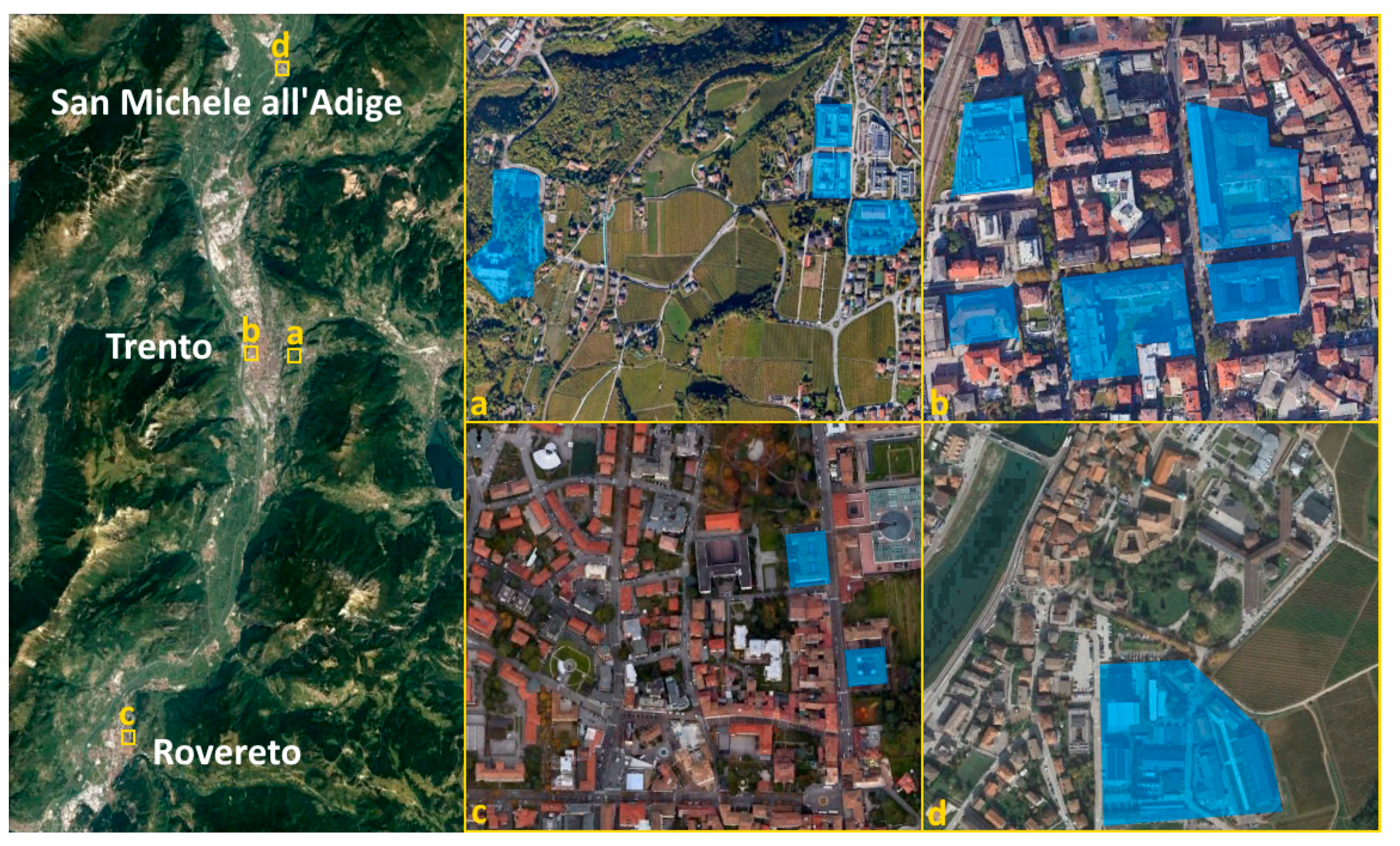
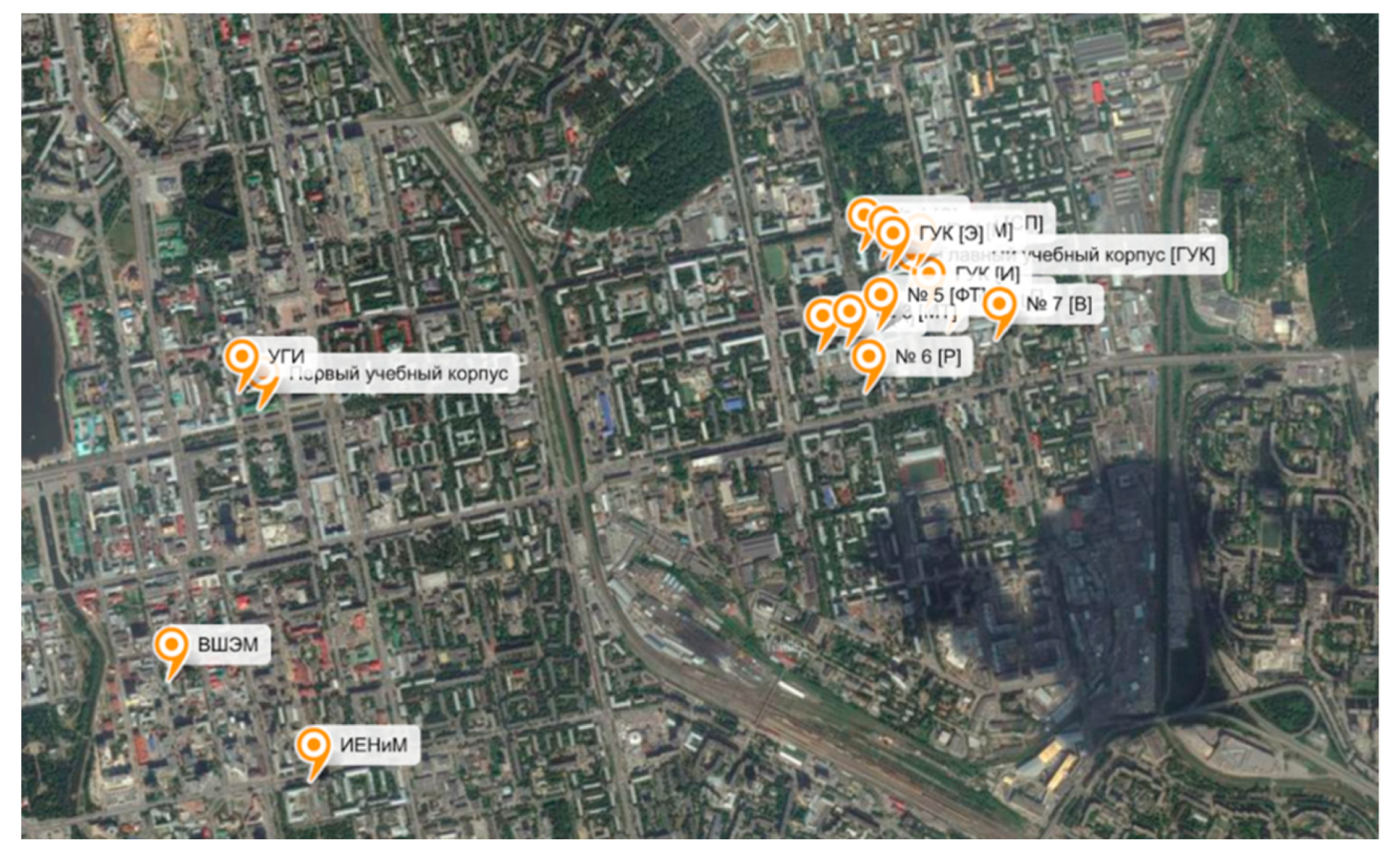
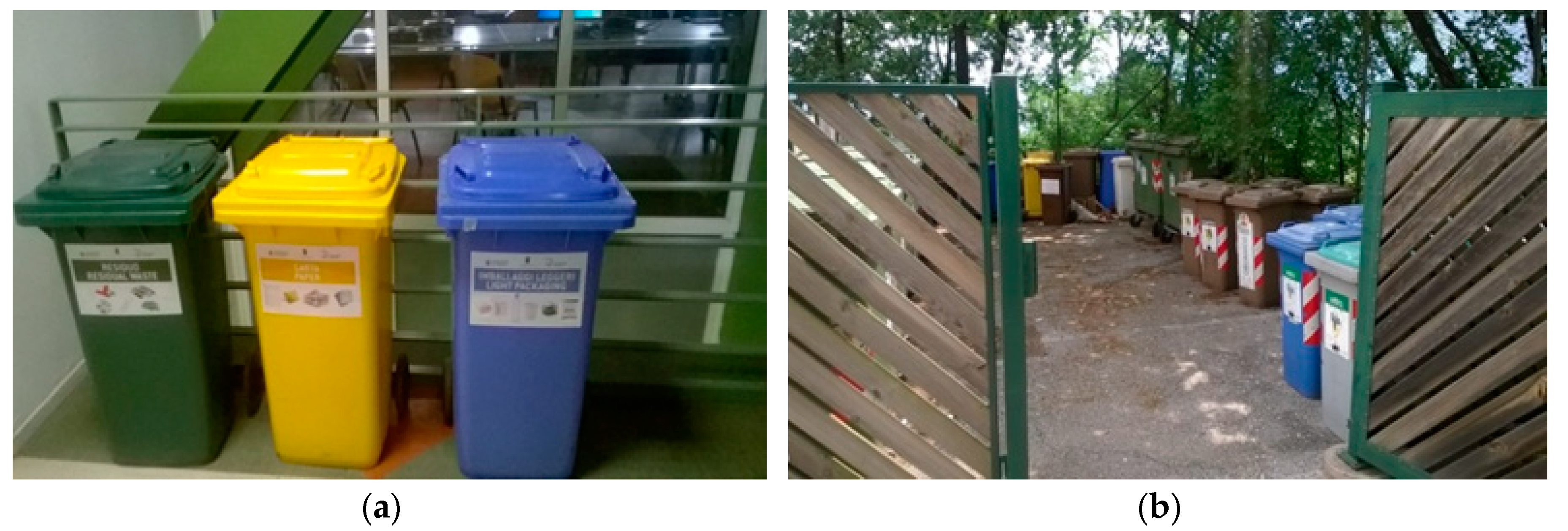
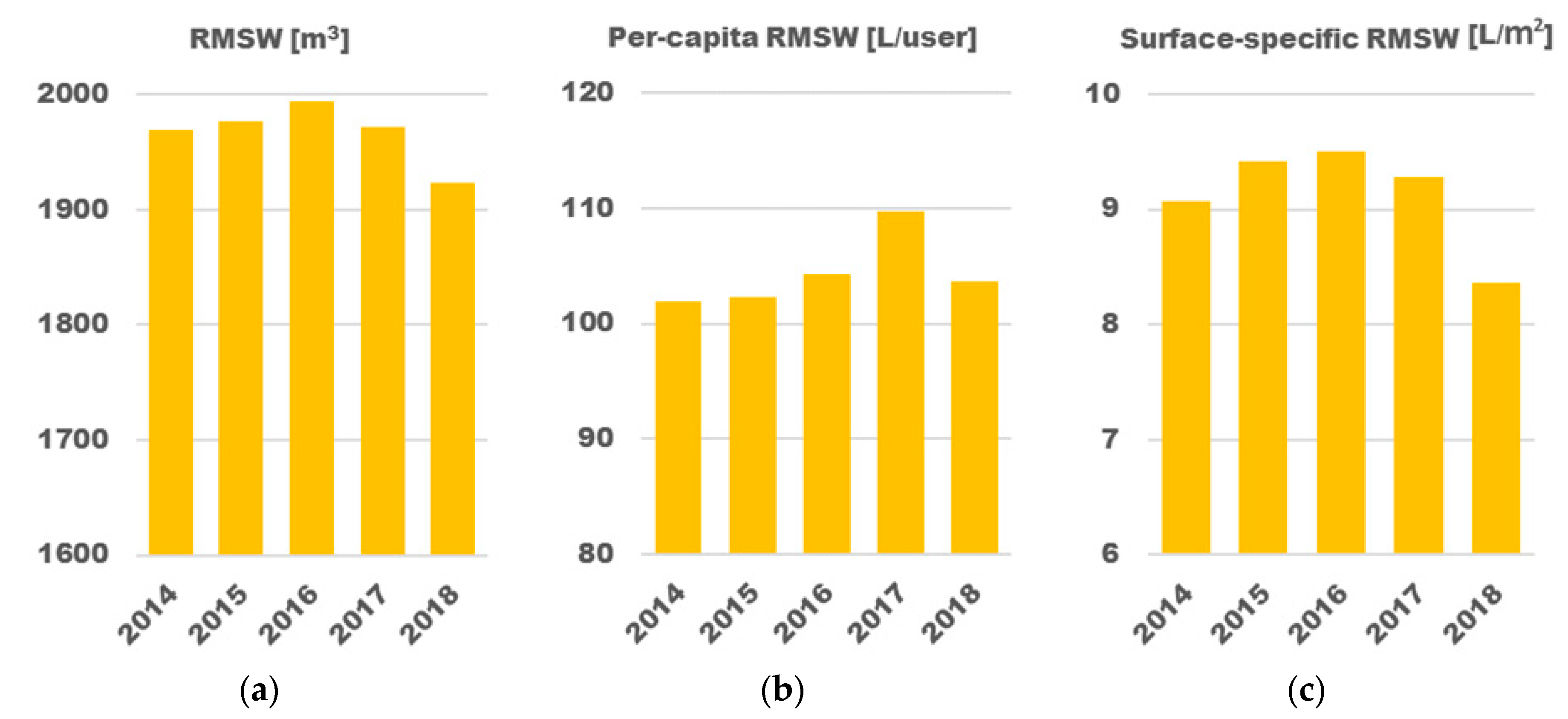
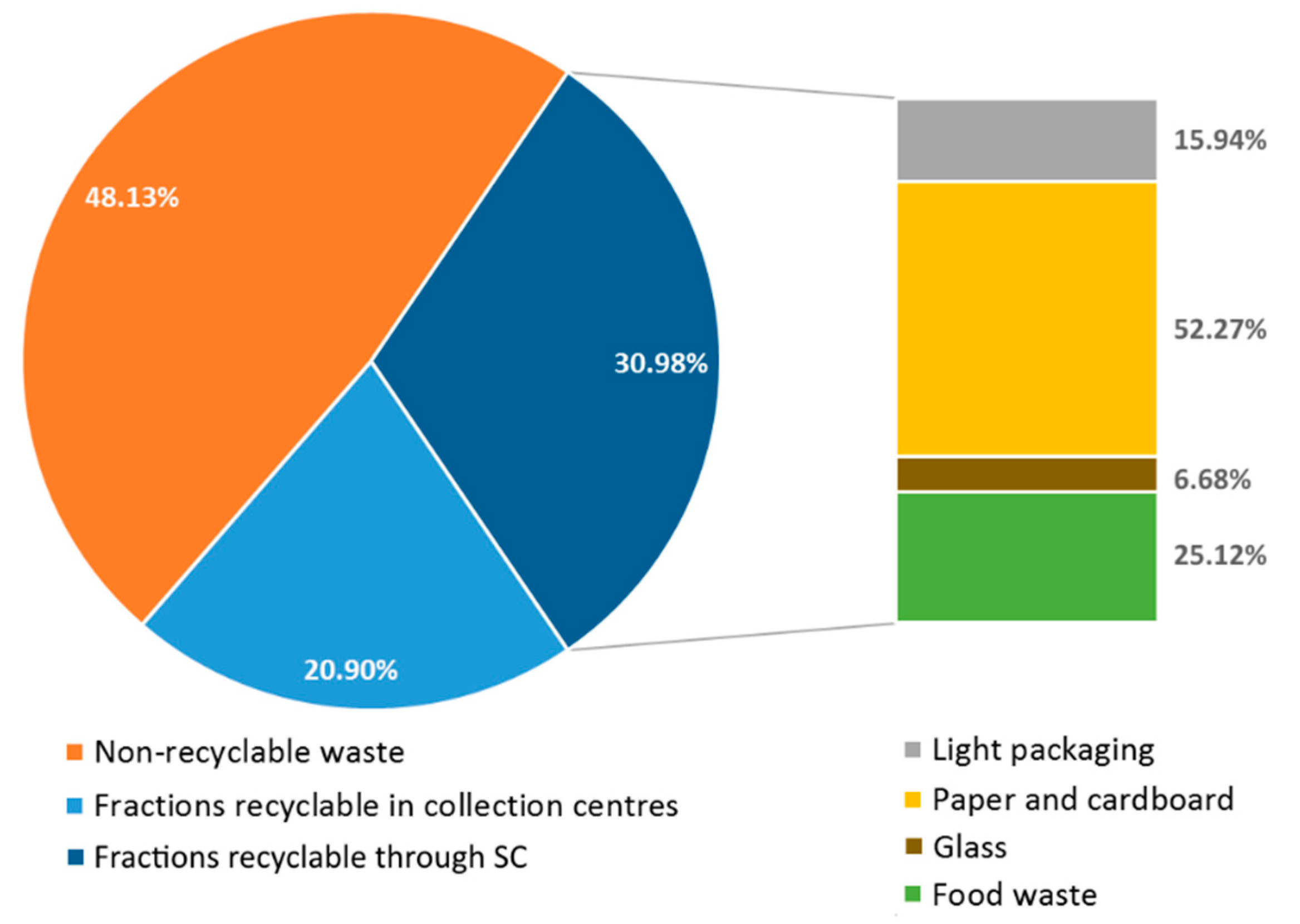
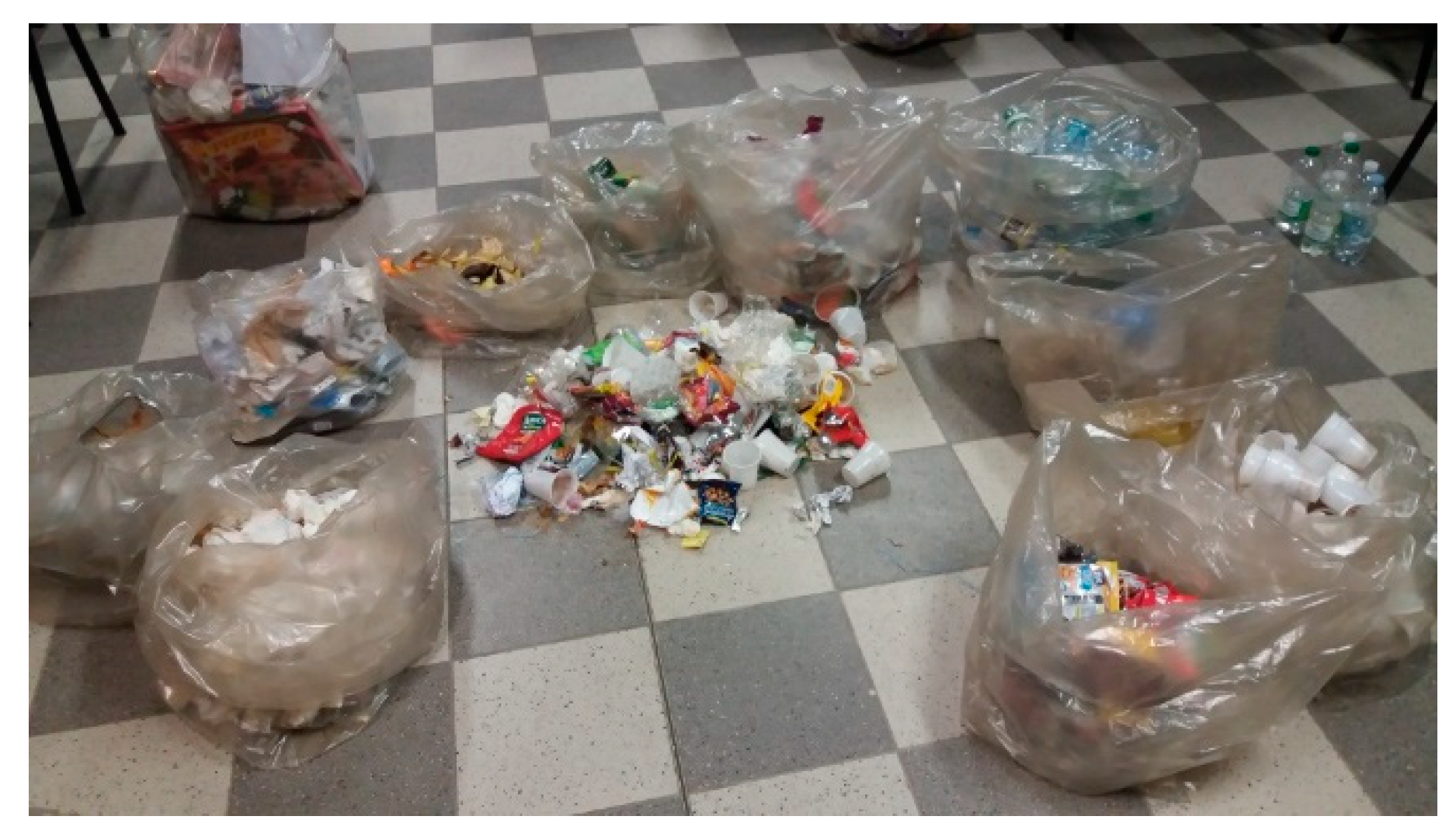
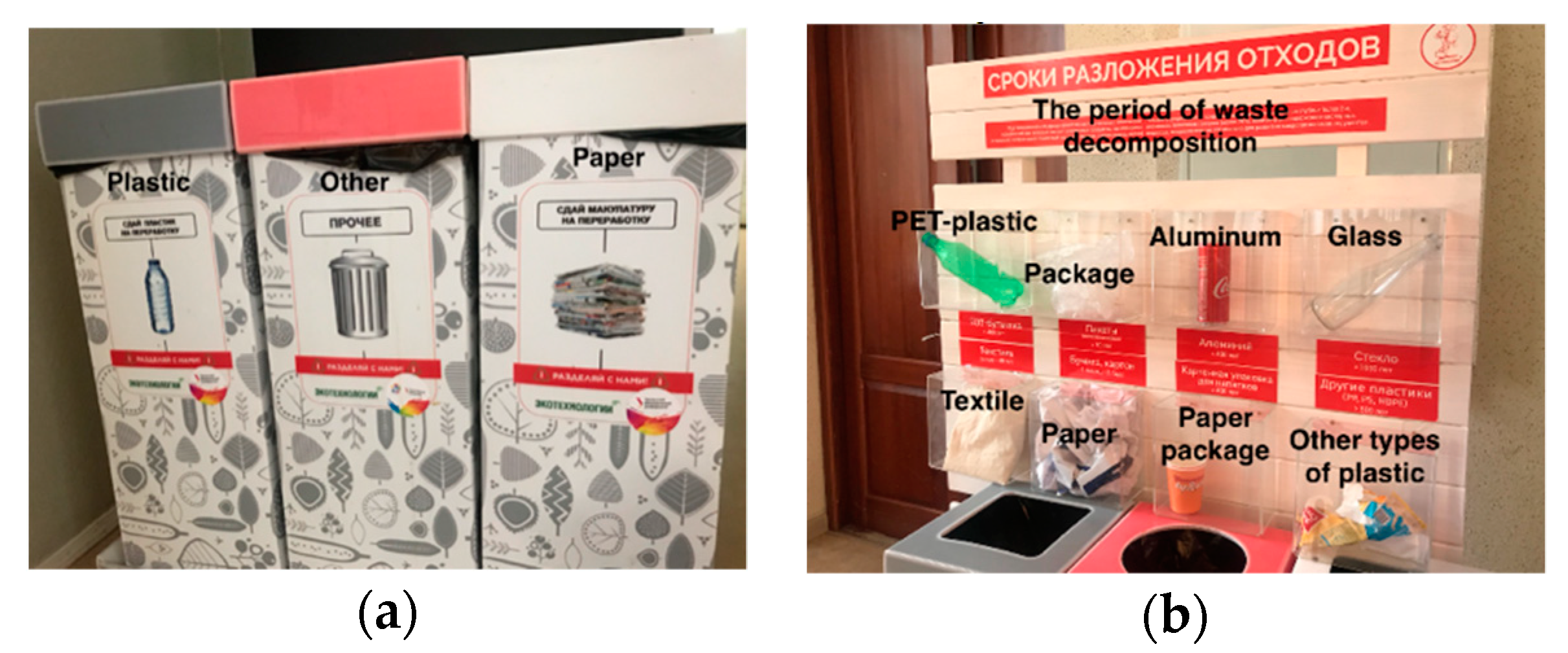
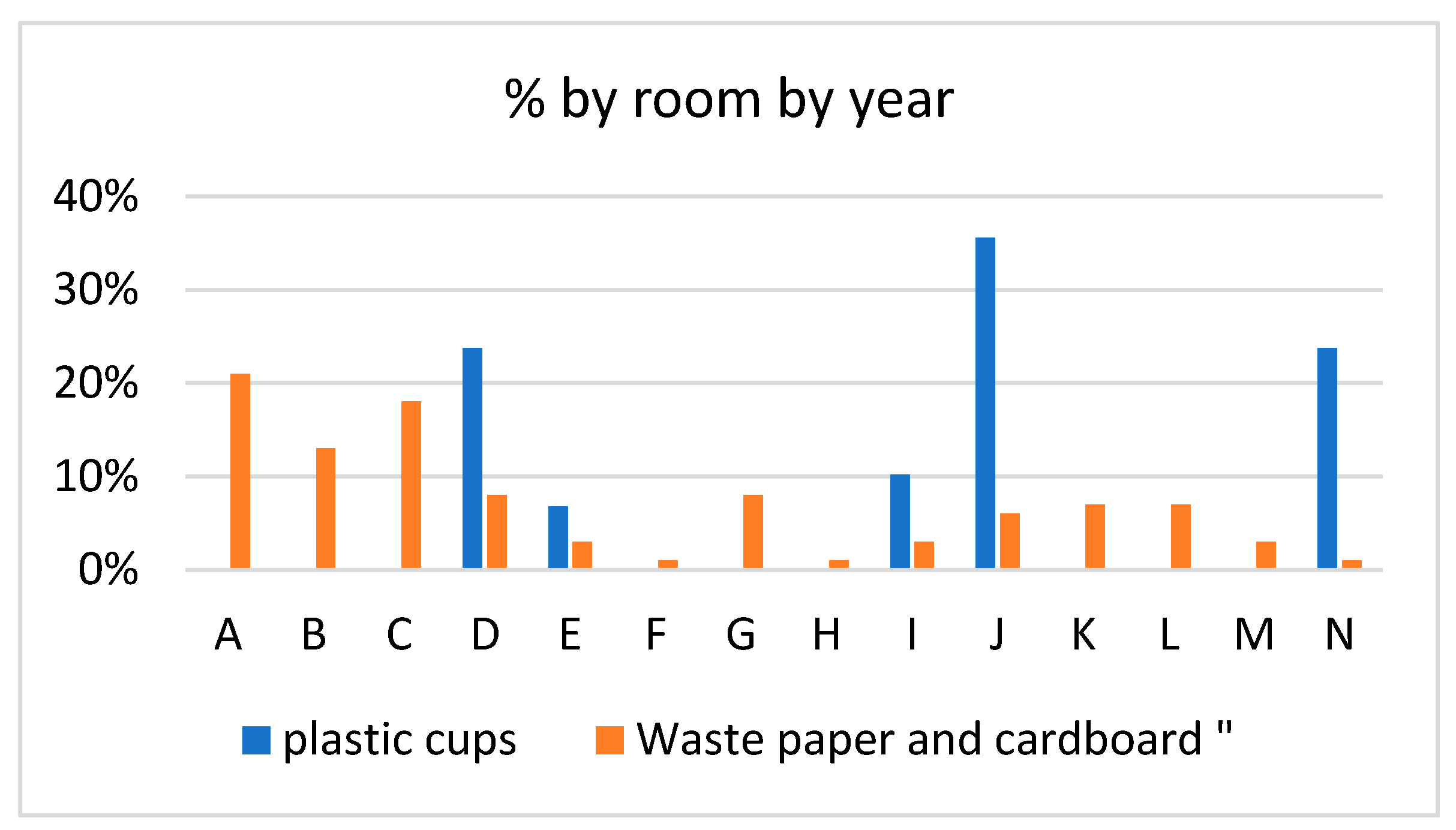
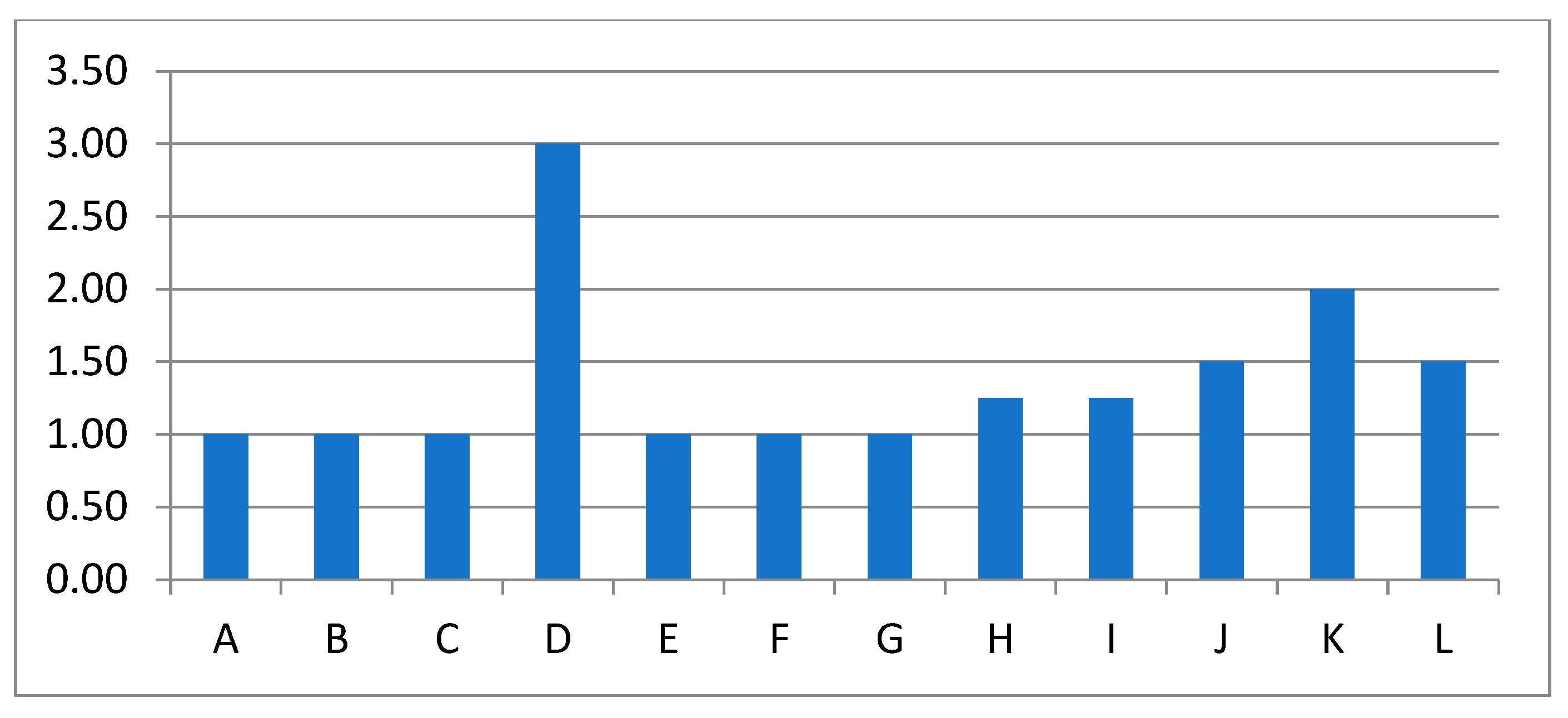
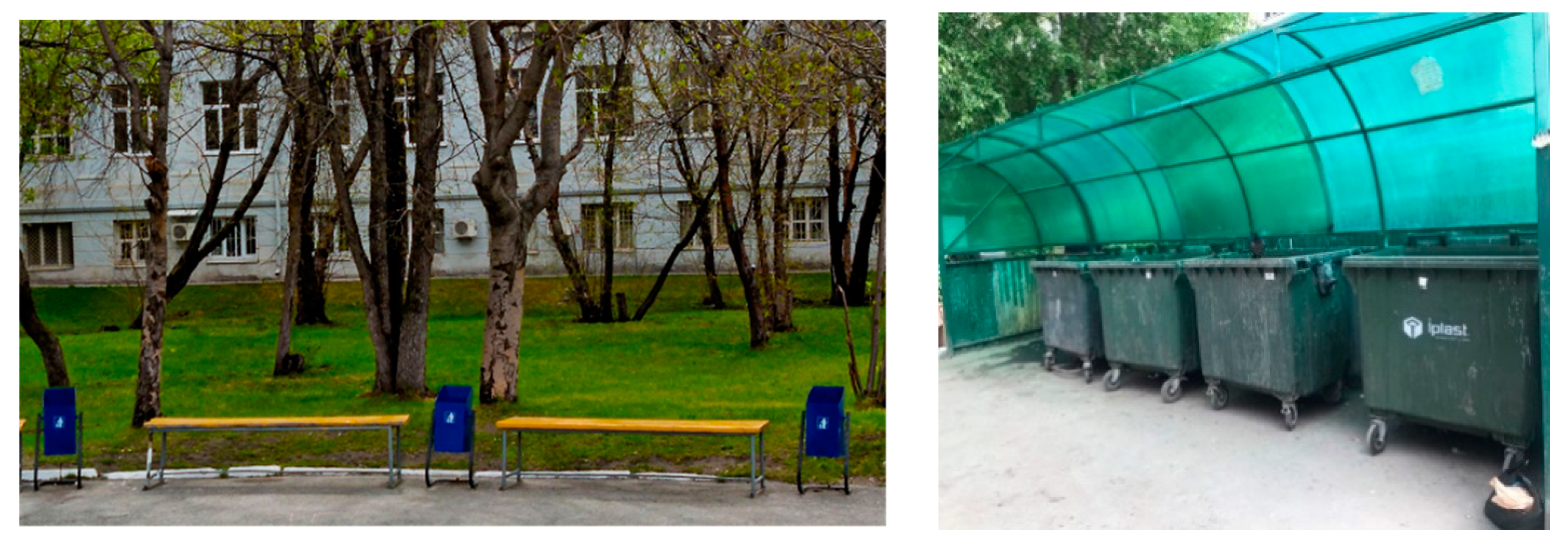
| Name of University | Number of Containers | Notes |
|---|---|---|
| Higher School of Economics (Moscow) | 16 | - |
| Northern (Arctic) Federal University named after M.V. Lomonosov (Arkhangelsk) | 11 | - |
| Astrakhan State Technical University (Astrakhan) | 6 | 4 fractions |
| Kazan (Volga Region) Federal University (Kazan) | 16 | - |
| Immanuel Kant Baltic Federal University (Kaliningrad) | 4 | 3 fractions |
| Minin Nizjhy Novgorod Pedagogical Iniversity (Nizjhy Novgorod) | 40 | 20 for PET bottles and 20 for scrap paper |
| Altai State University (Rubtsovskii Insitute) (Rubtsovsk) | 20 | 3 fractions |
| Saint Petersburg State University (Saint Petersburg) | more than 600 | 12 fractions |
| Waste Type | Quantity at Vending Machines |
|---|---|
| Polypropylene—PP | 41.1% |
| High-density Polyethylene—HDPE | 0.8% |
| Other paper (mixed paper magazines, mail)—PAP | 0.8% |
| Paper and cardboard/plastics/aluminum | 6.9% |
| Aluminum—Al | 7.3% |
| PolyethyleneTerephthalate—PET | 37.3% |
| PolyvinylChloride—PVC | 0.1% |
| Plastics/Aluminum (plastic toothpaste tubes/some vacuum packed coffee bags) | 0.8% |
| HighDensityPolyethylene—HDPE | 0.7% |
| Plastic/Miscellaneous metals | 1.8% |
| Polystyrene—PS | 2.4% |
| University | The Present Waste Management System | Proposed Improvements |
|---|---|---|
| University of Trento, Italy | The SC is implemented in every university building; the SC is designed to collect paper and cardboard, light packaging, residual fraction, nearby canteens the SC also includes glass and food waste, and the last fraction is also available near vending machines; The university carries out communication campaigns about the necessity and importance of separate waste collection; The university has an efficient waste management system; The significant amount of generic waste bins causes problems with correct waste separation; Students who come from other municipalities might have difficulties with the SC; Unauthorized users might avoid paying the waste management tariff | Generic waste bins should be removed from the university buildings; Communication campaigns should be set up periodically; A standard procedure for the correct management of waste containers in the external areas should be developed to reduce costs; A monitoring system should be implemented in order to avoid unauthorized users to enter |
| Insubria University, Italy | The SC is not totally implemented at university buildings; The university participates to the RUS® WW group; The per capita cost of managing urban waste at the regional level is lower than the national average (126 euros in comparison to 174 euros) | Generic waste bins should be removed from the university buildings; Communication campaigns should be set up periodically; A standard procedure for the correct management of waste containers in the external areas should be developed to reduce costs; Introduction of punctual pricing |
| Ural Federal University, Russia | The university does not have a well-organized waste management system at the moment; The SC project started in 2018 and currently, there are only five places with separate waste collection bins which are located only at the main university buildings; The current SC includes only three fractions: plastics, paper, and other waste; The SC project includes special instructions about SC and its importance; Insufficient volume of basket types throughout the university; The absence of separate waste collection and the lack of baskets in some external areas; Annually the university announces the collection of scrap paper | The SC should be implemented in all buildings and especially in dormitories; The following fractions should be implemented: residual fractions, glass, and food waste; The data about the waste collection should be collected and analyzed periodically |
© 2020 by the authors. Licensee MDPI, Basel, Switzerland. This article is an open access article distributed under the terms and conditions of the Creative Commons Attribution (CC BY) license (http://creativecommons.org/licenses/by/4.0/).
Share and Cite
Rada, E.C.; Magaril, E.R.; Schiavon, M.; Karaeva, A.; Chashchin, M.; Torretta, V. MSW Management in Universities: Sharing Best Practices. Sustainability 2020, 12, 5084. https://doi.org/10.3390/su12125084
Rada EC, Magaril ER, Schiavon M, Karaeva A, Chashchin M, Torretta V. MSW Management in Universities: Sharing Best Practices. Sustainability. 2020; 12(12):5084. https://doi.org/10.3390/su12125084
Chicago/Turabian StyleRada, Elena Cristina, Elena Romenovna Magaril, Marco Schiavon, Anzhelika Karaeva, Maxim Chashchin, and Vincenzo Torretta. 2020. "MSW Management in Universities: Sharing Best Practices" Sustainability 12, no. 12: 5084. https://doi.org/10.3390/su12125084
APA StyleRada, E. C., Magaril, E. R., Schiavon, M., Karaeva, A., Chashchin, M., & Torretta, V. (2020). MSW Management in Universities: Sharing Best Practices. Sustainability, 12(12), 5084. https://doi.org/10.3390/su12125084









